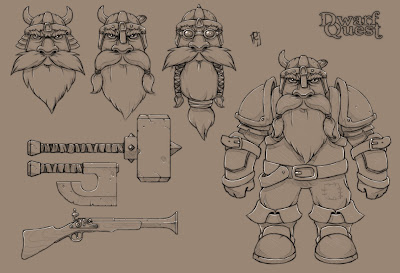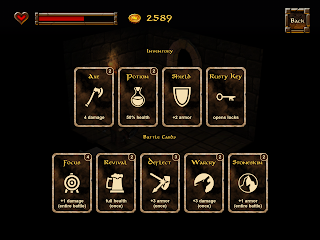
After graduating from highschool, I
considered studying computer sciences to expand my programming
skills. However, at the time I felt I should instead broaden my
horizon, and chose archaeology as my main course. Time at Uni was
super, resulting in a number of great trips (for example to the
Caribbean and Mexico) and a Master's Degree. Somehow it didn't feel
completely right though, and I quickly found myself back with my
original love: creating interactive media. I did a lot of freelance
work before cofounding game company Paladin Studios in 2005.
After more than five wonderful years at
Paladin, I decided to fly solo again. Then in December 2011,
inspiration stuck and I knew I would make another Dwarf Quest game.
I dug up the original trilogy and
analyzed what worked and what didn't. I even got a bunch of friends
together to play HeroQuest again, and within moments we were back in
the '90s. I made notes of what I liked and what might need some work.
Ultimately I decided that this new Dwarf Quest would borrow fewer
elements from its progenitor, going for a more original experience.
At its heart, though, would be exploration, finding treasure and
battling monsters.
Early on I knew I wanted to make an
iPad game. The beautiful screen and intuitive touch controls would
allow me to create a very approachable and elegant product. Taking a
clue from various popular games at the time (most notably casual
titles on Facebook), I kept the isometric perspective and built a
super simple point-and-click interface. In fact, during development I
would constantly take out buttons and options to make the overall
experience even more intuitive. Using the development platform Unity,
I was very happy to be programming again after all these years.
Understandably, all of the visuals
needed an overhaul. I hired a talented concept artist to make designs for the dwarf as well as the
monsters. This time around, I intentionally avoided the HeroQuest
specific enemies. I left the Minotaur in there as a reference to the
original trilogy. Also included was evil Lord Azar, who might have
gotten away in the '90s version, but would now face justice!
In addition I commissioned the creation of the 3D models, textures and animations, and was very happy with the result. I invited friends of mine to create the music and sound design. After hearing the first amazing track they made, I realized this version of Dwarf Quest had to and indeed would become something bigger than I had anticipated.
The nine levels in the game are a mix
of random generation and hand-crafted design. A system would create a complete
grid of randomly sized rooms connected by corridors. I would then take out
certain chambers, resulting in paths through the maze. Monsters,
furniture, traps and bridges were added manually.
Just like with HeroQuest, gameplay
became much more interesting as soon as cards were added. Named
'Battle Cards' in Dwarf Quest, these can be found throughout the
dungeon levels and boost your stats during combat. For a fee you can
also receive these divine blessings at altars.
I am proud to say that Dwarf Quest seems to appeal to a great number of people. When shown at the Indigo Showcase event, players of both sexes and all ages tried the game and told me they really enjoyed its apparent simplicity. And ultimately that's why I make games: to create worlds for people to experience, to feel positive and heroic about themselves.
Check out the game's website, which includes a link to the App Store: http://www.dwarfquestgame.com
As for the future: there's a Mac
version of Dwarf Quest in the works, and I received a lot of requests
for an Android port as well. And of course I already have plans for a
new installment in the franchise!
Well, that concludes the story of Dwarf
Quest, of how it came to be back in the '90s and how it lead to its
recent remake. I hope you enjoyed it, and thank you for reading!















Be sure to let us know when other versions are released. I'm extremely interested in an Android port myself.
ReplyDelete